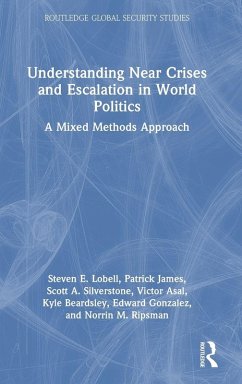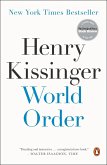Steven E. Lobell, Patrick James, Scott A. Silverstone
Understanding Near Crises and Escalation in World Politics
A Mixed Methods Approach
Steven E. Lobell, Patrick James, Scott A. Silverstone
Understanding Near Crises and Escalation in World Politics
A Mixed Methods Approach
- Gebundenes Buch
- Merkliste
- Auf die Merkliste
- Bewerten Bewerten
- Teilen
- Produkt teilen
- Produkterinnerung
- Produkterinnerung
This book analyses the near crisis phase of conflict and escalation in world politics.
Andere Kunden interessierten sich auch für
![Observing Conflict Escalation in World Society Observing Conflict Escalation in World Society]() Richard BöschObserving Conflict Escalation in World Society44,99 €
Richard BöschObserving Conflict Escalation in World Society44,99 €![Eretz Israel and Palestine. The question about escalation in the Middle East Eretz Israel and Palestine. The question about escalation in the Middle East]() Christian KutzscherEretz Israel and Palestine. The question about escalation in the Middle East17,95 €
Christian KutzscherEretz Israel and Palestine. The question about escalation in the Middle East17,95 €![The Shanghai Cooperation Organization and Conflict De-escalation The Shanghai Cooperation Organization and Conflict De-escalation]() James MacHaffieThe Shanghai Cooperation Organization and Conflict De-escalation149,99 €
James MacHaffieThe Shanghai Cooperation Organization and Conflict De-escalation149,99 €![World Politics World Politics]() Brian HockingWorld Politics131,99 €
Brian HockingWorld Politics131,99 €![On Escalation On Escalation]() Herman KahnOn Escalation168,99 €
Herman KahnOn Escalation168,99 €![World Order World Order]() Henry KissingerWorld Order9,99 €
Henry KissingerWorld Order9,99 €![World Order World Order]() Henry KissingerWorld Order10,99 €
Henry KissingerWorld Order10,99 €-
-
-
This book analyses the near crisis phase of conflict and escalation in world politics.
Produktdetails
- Produktdetails
- Verlag: Routledge
- Seitenzahl: 168
- Erscheinungstermin: 31. Juli 2025
- Englisch
- Abmessung: 240mm x 161mm x 14mm
- Gewicht: 423g
- ISBN-13: 9781041007173
- ISBN-10: 1041007175
- Artikelnr.: 73534874
- Herstellerkennzeichnung
- Libri GmbH
- Europaallee 1
- 36244 Bad Hersfeld
- gpsr@libri.de
- Verlag: Routledge
- Seitenzahl: 168
- Erscheinungstermin: 31. Juli 2025
- Englisch
- Abmessung: 240mm x 161mm x 14mm
- Gewicht: 423g
- ISBN-13: 9781041007173
- ISBN-10: 1041007175
- Artikelnr.: 73534874
- Herstellerkennzeichnung
- Libri GmbH
- Europaallee 1
- 36244 Bad Hersfeld
- gpsr@libri.de
Steven E. Lobell is a Professor in the Department of Political Science at the University of Utah, USA. Patrick James is the Dean's Professor Emeritus of International Relations at the University of Southern California, USA. Scott A. Silverstone is a Professor of International Relations at the United States Military Academy at West Point. Victor Asal is the Director of the Center for Policy Research and Professor of Political Science at the University at Albany, USA. Kyle Beardsley is a Professor of Political Science at Duke University, USA, the Director of the Triangle Institute for Security Studies, and the Co-Director of the International Crisis Behavior Data Project. Edward Gonzalez is an Instructor of Political Science at Compton College, USA. Norrin M. Ripsman is the Monroe J. Rathbone Distinguished Professor of International Relations at Lehigh University, USA. Shikshya Adhikari works as a Research Associate. She has experience working with advanced statistical techniques and data analysis tools. She is a mixed-methods researcher. She has worked for humanitarian response projects. She has an M.A. in Political Science and an M.S. in Sociology. Suzanne Weedon Levy currently serves as the Director of Grants for a non-profit in New York's Capital Region. Prior to transitioning to the non-profit sector, she spent almost a decade as the Research Director of the Project on Violent Conflict (PVC) at the University at Albany, where she focused on the behavior of terrorist and insurgent non-state actors. Grace Sorci currently works as a Senior Research Associate at The Chicago Lighthouse. At the time of this project, she served as a Research Aide and Project Supervisor for the Project on Violent Conflict (PVC) at the University at Albany. Nakissa Jahanbani is an Adjunct Lecturer at the Pennsylvania State University and a Senior Analyst at the Afghanistan War Commission in the Senate. Her research focuses on how states partner with violent non-state actors. Anne van Wijk obtained her PhD in Political Science and International Relations from the University of Southern California in 2022. In her dissertation, van Wijk discusses the constraints under which states operate as members of international organizations and untangles how and when international cooperation is likely to break down.
Chapter 1: Near Crises and the Process of Escalation in World Politics
Chapter 2: Near Crises and Escalation Processes: A Systemist Exposition
Chapter 3: Dissecting the Dynamics of Near Crisis: Introducing the
Diplomatic, Informational, Military, and Economic (DIME) Moves Dataset
Chapter 4: Postures and Portents: Action-Level Predictors of Near Crisis
Escalation Chapter 5: Terrorist and Insurgent Organizations in Near Crises:
Who Participates and Why? Chapter 6: Implications of Near Crises for the
Policy Practitioner Community Chapter 7: What Have We Learned?
Chapter 2: Near Crises and Escalation Processes: A Systemist Exposition
Chapter 3: Dissecting the Dynamics of Near Crisis: Introducing the
Diplomatic, Informational, Military, and Economic (DIME) Moves Dataset
Chapter 4: Postures and Portents: Action-Level Predictors of Near Crisis
Escalation Chapter 5: Terrorist and Insurgent Organizations in Near Crises:
Who Participates and Why? Chapter 6: Implications of Near Crises for the
Policy Practitioner Community Chapter 7: What Have We Learned?
Chapter 1: Near Crises and the Process of Escalation in World Politics
Chapter 2: Near Crises and Escalation Processes: A Systemist Exposition
Chapter 3: Dissecting the Dynamics of Near Crisis: Introducing the
Diplomatic, Informational, Military, and Economic (DIME) Moves Dataset
Chapter 4: Postures and Portents: Action-Level Predictors of Near Crisis
Escalation Chapter 5: Terrorist and Insurgent Organizations in Near Crises:
Who Participates and Why? Chapter 6: Implications of Near Crises for the
Policy Practitioner Community Chapter 7: What Have We Learned?
Chapter 2: Near Crises and Escalation Processes: A Systemist Exposition
Chapter 3: Dissecting the Dynamics of Near Crisis: Introducing the
Diplomatic, Informational, Military, and Economic (DIME) Moves Dataset
Chapter 4: Postures and Portents: Action-Level Predictors of Near Crisis
Escalation Chapter 5: Terrorist and Insurgent Organizations in Near Crises:
Who Participates and Why? Chapter 6: Implications of Near Crises for the
Policy Practitioner Community Chapter 7: What Have We Learned?








